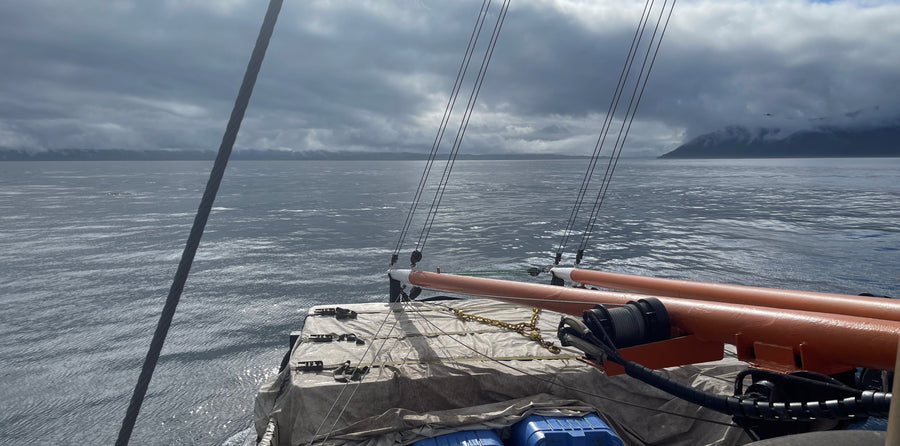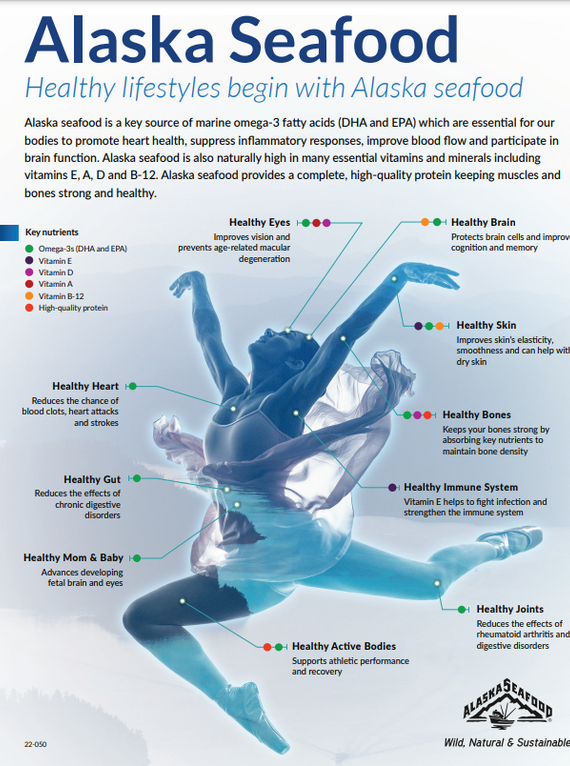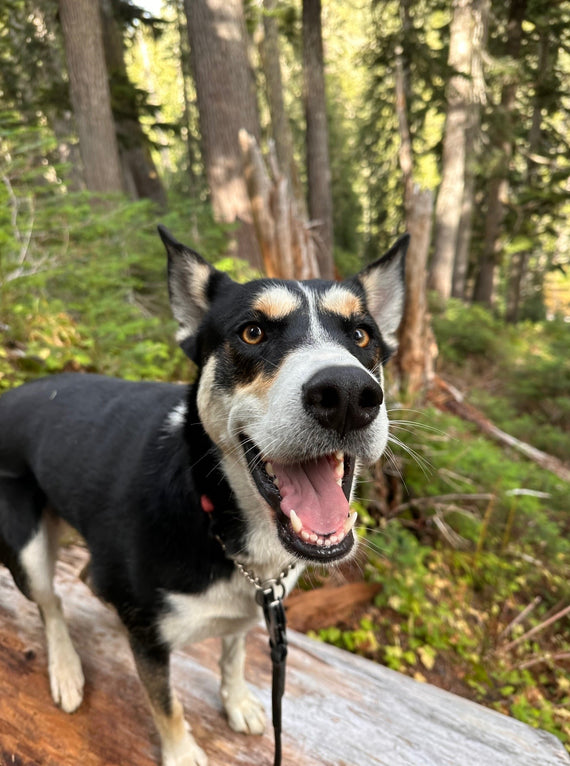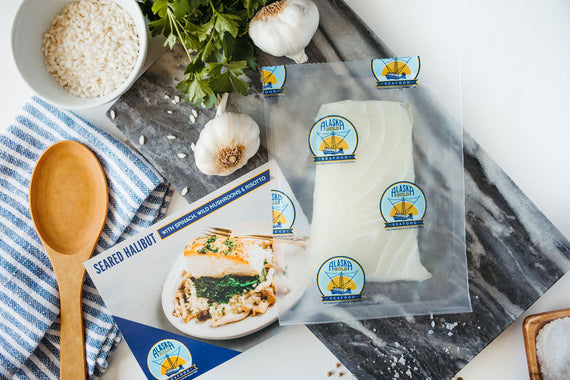
In our Sitka-based fishermen-owned co-op, we specialize in selling line-caught wild Alaskan salmon. As an Alaska Gold Seafood fish monger, I like to get out and see the fishermen and what they do in action. And the perfect opportunity came recently when I could hop on the Sea Lion, our salmon-buying scow. A buying scow, or tenders as we call them, is a boat that meets our fishermen where they are on the grounds to buy their fish and service them with fuel, ice, groceries and, maybe more importantly, community, as I will try to show through my journal. I focus on service in this first part of the journal and in this part the idea of community in the troll fleet.
Journal continued below.

The Sea Lion in the distance
7-22-22 Hole in the Wall, San Lorenzo Island, Southeast Alaska
Early today we hear from an old friend Tom Fisher, known as “The Fish,” a favorite character of mine who calls in on the radio from his boat the Aquarius—“It’s that grumpy captain on the line,” he barks, and I instantly recognize Tom’s voice. Greg and I know we’re going to get an earful. We unload Tom’s fish and invite Tom up for breakfast—biscuits and gravy and some eggs. Tom usually has a deckhand but doesn’t this year. “I told him that I’d be untying from the dock at 6, and it was 6:30 and he wasn’t there, so I left and he was fired.” Tom starts philosophizing about pride in workmanship, the sense of community among trollers, doing things the old-fashioned way, finding old lures on Ebay that he likes. “I re-tie my leaders every time on my chrome McMahon #7s. They just don’t make lures like that anymore and I can’t stand to lose the lure.” And they really don’t make boats like the wooden boats we see out on the water here anymore. Or people for that matter. Some of the fishermen we meet live such a unique rugged life out on their own—they work with their hands, eking out an existence in truly remote country, in what I think of as a really authentic existence.
And then Tom recalls a story he heard on the radio with two fishermen talking about the origin of the word “hayrack.” A hayrack, from what I know, is a rack on the back of a trolling boat where fishermen might hang gear, like a skiff or other equipment. And the story was about an old inventive fishermen going down to the dock every day, welding pipes and parts together with a torch, and other fishermen asking him “Whacha building there?” every day. And then as the rack got closer to completion, the conversations became something like “Hey, what’s that rack?” And I’ve always heard “hayrack,” but now I understand that it’s “hey rack” as in short for “Hey, what’s that rack?” It’s a small epiphany in my fish monger career, but it was worth a laugh for all of us over an early morning coffee. “Man, the worst thing that happened to the troll fleet are these InReach texts,” Tom says referring to the satellite communication texting that fishermen now use in lieu of a radio which makes their conversations public. “We used to hop on the radio. There was a sense of community. You could listen in on other fishermen’s conversations and try to guess how many fish they were catching by their coding.” Tom references the coding that went on that allowed fishing friends or coding partners to share their fish scores without everybody else on the radio knowing what they were talking about. “Along with that loss of community came a loss of etiquette,” Tom philosophizes.
It’s true everything that Tom says. Tom has essentially given his life to fishing. It is his existence. His identity. I cannot imagine him doing anything else. He has also been on the board of a number of fishermen’s organizations, including a board member of our fishermen-owned co-op. He is the real deal. And it’s always good to catch up with him and he makes some good points about the sense of community within the fishing fleet.
Though I also recognize the other side of the coin as I talk more with Greg. Greg notes that yes, fishermen talk on the radio less than they used to, and maybe there is a loss of community there with conversations going back and forth about all sorts of topics for all the fleet to hear and be in on in a sense of community in which everybody participated. But Greg does spend time texting with fishermen, getting really useful information from them that they can share better through text messages. He can get deeper because they don’t have to veil what they’re saying with codes, like they do on the radio. He also knows which fishermen have the most useful, trustworthy, reliable information, and he forms a more one-on-one relationships with them. And a tender operator like Greg is perfect for the job because he's affable and trustworthy, and becomes the nexus of this information. The Sea Lion indeed provides community to the trollers and preserves their unique lifestyle because it is a nexus of information.
After Tom Fisher on the Aquarius, we get a string of boats that deliver fish to us, ice and fuel up, and get back on the water. The Tyee, the Virginia Rose, the Marcia K, and the Alta E all represent a bastion of fishermen having success most likely on the trolling drags near Noyes Island and Cape Addington, making a living far from civilization. Joe Sebastian, on the Alta E, a wooden trolling boat built in 1937, tells me about a number of the other fishermen he’s fished with and his homesteading life on Kupreanof Island. “I grew up learning from the fishermen who came back from World War II. After what they went through, they didn’t want to take any more orders and they became fishermen. And they learned how to live on their own out in the wild Alaskan wilderness before it became a state. And my generation has been rebellious in our own way, also making a living on the land out here.” Nearing 70, Joe talks about the other fishermen he knew who retired and sold their gorgeous old wooden boats—“they’re a lot of work”—but then they missed the lifestyle so much that they had to start all over again with cheap fiberglass boats to get back fishing again. On wooden boats, “You put your whole heart and soul into it,” Joe says. “And I’ve put my whole heart and soul into this fishing career.” Joe loves the Sea Lion because, like the Alta E, it's a classic wooden boat with character. "The Sea lion is its own time warp into all the good things we hope to find in a life. That boat is a haven for generations of the human spirit who yearn towards the sea, and in a small way reap and partake of its holy bounty and treasure!"

The Alta E pulling up to the Sea Lion
After my afternoon chatting with the boats that come by, I realize that the tender is preserving a way of life for these fishermen. Our co-op is preserving a lifestyle for a very difficult way to make a living. These are some of the last people working an honest living out there. Like Tom Fisher said, “We’re the last of the hippie troll fleet, living off the land in one of the most honest, wholesome ways possible. We catch fish. We get paid by how many pounds of fish we catch. And it’s an honest existence.”
There’s something glorious about working with your hands and not seeing the news for a week. My back is sore from shoveling ice and I’ve been ultra-cautious, but I can see that fishing and working on a tender can also be dangerous. But it’s deeply satisfying in a way that working in front of a computer isn't.
Greg told me about dislocating his shoulder on his first day of his first trip while slipping off a tote and catching himself with his shoulder. And he can still feel the pain now. But the most difficult thing to do on a tender is what I’ll call Tender Tetris, a game of putting each tote in the best place to work as efficiently as possible for the crew, remembering which totes have ice and which have fish, and which grades of fish they have, and how the positioning of these totes changes over a trip. We play the game of Tender Tetris every evening on this trip, but on this last evening of tendering, it becomes even more complicated, as we also need to make sure that the totes are in good position to make the long ride back to Sitka.

Tender Tetris
Sometime after 11pm, hosed down, disinfectant sprayed, totes moved into their best positions on the deck, we pull out of Hole in the Wall with over 22,000 pounds delivered of salmon from 14 salmon trolling boats--the Aurora, the Sika, the Carolyn L, the McKenna S, the New Adventure, the William, the Faith, the Aquarius, the Tyee, the Alta E, the Psarema Thea, the Tia, the Virginia Rose, and the Marcia K. And now we begin the long ride back to Sitka. Here’s where the caffeine becomes even more necessary.
We’ve got roughly an 18-hour run back to Sitka. With some re-wiring, the navigational program on the computer could be hooked up to the Auto-pilot and one could plot a course and the auto-pilot could in theory take you to your programmed destination while we sleep. But there are rocks and logs and boats and other obstacles. Within some kelp beds could hide a large log. Even a small log, if it’s water-logged, can do some damage that can really add up over a season. Or something else. And who knows? A solar flare could cause the compass to be off a quarter of a degree and that would make a huge difference in these small bays, narrow channels, and rocky coasts. So one of us, usually Greg or Wes, stays up and does the wheel watch, steering us out in the big ocean and back north to Sitka.
7-23-22
We push on to our Sitka seafood processing plant all night and in the morning I take a walk out on the deck and watch a whale follow us for a while and then wave goodbye with its flukes. I pull out my mandolin, play some tunes and relax and wait for the Sitka arrival. It isn’t until evening that we arrive at the Sitka seawall right by the SPC plant. I hop out and watch Greg use the boom to unload all the totes of fish and the forklifts bring the salmon to the plant to be processed. Once unloaded, Greg and crew will do some grocery shopping for the Sea Lion and for the fishermen out on the water. And do it all over again within a matter of hours. I’ll head back to the office to answer customer questions and the Sea Lion crew will keep doing this the rest of the season through September.



